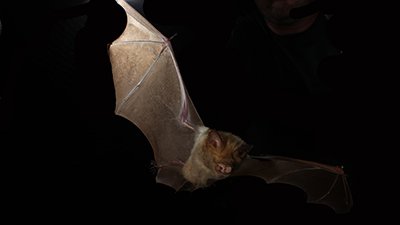Six Evolutionary Clichés and How to Answer Them
On National Cliché Day, we take a look at some of the most commonly used but wrong “examples of evolution.”
November 3 is national cliché day in the US. Around 1825, the word cliché was borrowed from the French to refer to the cast plate or block print used to replicate type or images for books or newspapers. Since cast plates were reused over and over again, the word cliché came to be associated with any ready-made phrases that are repeated often. According to the National Day website, this “day celebrates how useful, annoying, and fun clichés are by incorporating them into the conversation and the arts for the entire day.”
Here at AiG, we thought this might be a good day to highlight some of the more annoying clichés we repeatedly see used in science news propagated as “proof of evolution” when in fact it usually is proof against molecules-to-man evolution and actually supports biblical models of creation and speciation.
Natural Selection/Adaptation of a Species Is Evolution
One of the most common of the evolutionary clichés is some aspect of adaptation being labeled as “evolution.” In fact, Darwinian evolution was founded on such a cliché. Remember, it was Galapagos finches and their beak sizes that kick-started Charles Darwin’s thinking on little changes within a species extrapolated backward in time to equate to large-scale changes over millions of years, eventually leading back to a universal common ancestor.
One of the most common of the evolutionary clichés is some aspect of adaptation being labeled as “evolution.”
But adaptation and natural selection are observable processes. We can observe and record changes in populations of organisms as they adapt to their environment. Those that are better suited for the environment survive and reproduce. Those that aren’t often go extinct or become a much smaller segment of the population. But we also observe that these changes in many cases come at the cost of the loss of genetic information. This adaptability is often specific to the environment, and if the local or regional environment changes again, those that had previously adapted may find themselves at a survival disadvantage.
God tells us in Genesis that he created creatures “according to their kinds” and that at the time of the flood, two of each of these kinds (up to seven pairs of some) were taken onto the ark. Creation scientists have determined that, in the majority of cases, the biblical kind is roughly equivalent to the family level in our modern taxonomic classification system. Within each kind we see variation, adaptation, and speciation as organisms reproduce according to their kind. But we never observe one kind changing into another kind. The Galapagos finches remain finches.
Antibiotic Resistance Is Evolution
A common argument from evolutionists is that bacteria have evolved resistance to antibiotics. While it is true that antibiotic resistance is increasingly common among bacteria, this does not demonstrate evolution. In order to understand why, we need to understand how antibiotics work.
Generally speaking, an antibiotic works by disabling some key feature of a bacterium. In the case of penicillin, it disrupts the formation of the bacterial cell wall, leading to its death. To do this, the antibiotic must either bind with or enter the cell. Performing this task requires specific markers or pathways. If a bacterium has a mutation that prevents the antibiotic from attaching or entering, it becomes resistant by default. But that resistance is only helpful if the bacterium is in the presence of the antibiotic: if it isn’t, the bacterium is broken and will not compete well within its population. However, if that population causes an infection and an antibiotic is used, the resistant bacteria quickly lose competitors and so are able to multiply rapidly. When the antibiotic is removed, the non-resistant strains from elsewhere repopulate and quickly muscle out the resistant strain.
What we see here is that a mutation can be situationally beneficial. However, unless under stress from an antibiotic, the mutation is bad for the bacteria at large. This is like a serial killer going door to door and killing anyone who answers their doorbell. If your doorbell does not work, that’s great for you for that one ring, but for all the other times the doorbell should be ringing and doesn’t, you might be missing out on a publishing clearing house award.
Any Morphological Change and/or Stasis Is Evolution
We’ve read news items declaring that geckos growing slightly larger heads and mouths in order to eat larger insects is evidence of evolution. Or that crows and ravens growing larger and spreading out worldwide is evidence of evolution. Or that birds that visit your feeder are rapidly evolving bigger beaks. It seems that any morphological change, no matter how minute, is touted as proof of evolution. Ecological or dietary changes are also hailed and listed as evolutionary proofs.
And yet, when an animal undergoes little to no change for supposedly hundreds of millions of years, this too is touted as evolutionary proof. Many small animals that have been trapped in amber, from supposedly 100 million to 35 million years ago look so much like their modern counterparts that they can be assigned to living families or orders. From mayflies, lacewings and millipedes to geckos, there are examples of fossilized creatures which have undergone no evolutionary changes. The same can be said for fossils of creatures like coelacanths, horseshoe crabs, tuataras, crocodiles, and even ginkgo trees, which look exactly like their modern-day counterparts. Yet surprisingly this lack of change is considered to be an example of evolution.
The explanation for evolutionary stasis, meaning that the organism’s body form remains the same for a long time, is that either such organisms undergo little change because they are so well adapted to their environments or because the genes of some creatures evolve more slowly than most other creatures. In essence, either the creature is so perfectly designed for its environment that it doesn’t need to further evolve, or it evolves so slowly that the changes remain imperceptible for up to several-hundred million years. But what environment, even in an evolutionary perspective, has remained unchanged for tens to hundreds of millions of years? Conventional timing for the K-Pg extinctions is 66 million years, and supposedly the latest ice age occurred only 110,000–10,000 years ago. These are considered radical environmental changes, and yet many creatures supposedly sailed through them with no evolutionary change. Perhaps the problem, rather, lies in the two assumptions: evolution and evolutionary timescales.
“Everything We Thought We Knew About This Aspect of Evolution Has Changed”
On our weekly Answers News program, there is a frequently recurring theme when we cover evolutionary topics. A researcher makes the bold claim that his/her research overturns the commonly held evolutionary paradigm of a given subject. This happens so frequently that it has become (you guessed it!) a cliché. Whether it’s bat echolocation and moth ears, promiscuity actually hindering genetic diversity, 90% of species having a recent origin, or even the origin of multicellular animals, conventional scientific wisdom is frequently overturned.
As better methods are developed, more fossils come to light, and genetics is studied alongside fossil morphology, we should expect some research to be refined. But this is not the only thing at play here. Most of these studies radically revise what evolutionists have taught. However, even more disturbing is when a study done by evolutionary biologists completely debunks the prevailing evolutionary paradigm with solid data that cannot be refuted, and still it is completely ignored because it upsets the narrative being pushed as fact (case in point, an anatomical study that destroys the dinosaur–to–bird evolutionary story).
Raising Your Haeckel’s and Peppering Your Moths
Ernst Haeckel was an early German supporter of Darwin. He proposed the idea that the development of organisms follows the same path as their supposed evolution. In other words, “ontogeny recapitulates phylogeny.” Haeckel drew embryos of multiple species during development—including humans, fish, and other vertebrates—showing how they were supposedly similar to one another. Based on these drawings, it has been argued for almost two centuries that evolution is true.
The problem is that Haeckel’s embryos were complete forgeries. He drew different developmental stages next to each other, added and removed lengths to make them fit, and altered details to make the embryos more similar. This has been known since only a few years after Haeckel published the drawings. Haeckel himself was forced to issue a half-hearted correction and excuse for his conduct. Yet Haeckel’s embryos still managed to make an appearance in one of the authors’ 2021 graduate school lectures as evidence for evolution!
Another common evolutionary myth is that of the peppered moth. These moths supposedly land on trunks of trees where they either stand out or blend in depending on whether they match the color of the trunk. The camouflaged moths were not eaten, but the uncamouflaged ones were. The population then shifted toward the camouflaged moths. According to evolutionists, shifts in frequency of the moths that match the tree trunks proved that evolution was occurring.
There are two huge problems here. First, even if the entire peppered moth narrative were true, all it would prove would be that the frequency of color morphs in a population can fluctuate based on environmental conditions. Both color morphs, light and dark, already existed in the population. No new genes were even added. Population frequencies within the same species simply changed. This does not prove that peppered moths evolved from a single-celled organism over millions of years. It simply means creation is adaptable.
However, it turns out the entire moth narrative is a myth. Moths do not land on the trunks of trees during the day when birds might see and eat them. They are active at night. The photos of moths on tree trunks were staged photos of dead moths. The videos of birds eating moths off the trunks of trees were also staged using captive-bred moths. All of this is a matter of public record. Worse, despite birds preferring uncamouflaged moths, one study found that the uncamouflaged moths made up the majority of the population! This is the exact opposite of the predictions made by evolutionary textbooks. These two clichés need to follow the dinosaurs into extinction.
Vestigial Organs
Decades ago, it was common for evolutionary scientists to argue that humans had vestigial organs—the appendix being most cited. The argument was that evolution was an inefficient process and that when new organisms evolve, they often bring along baggage that is no longer necessary in the form of vestigial organs. In the past, the “vestigial” organs were presumed to be completely nonfunctional. Fast-forward to the present, and this argument has gone up in smoke. The appendix, and every other “vestigial” organ in the human body, has been shown to be functional. Even other supposed vestigial organs, like the “leg bones” of whales, have been shown to be functional.
The fact that most, if not all, “vestigial” organs have been shown to be functional has not slowed down the evolutionists one bit. Those that acknowledge that most so-called vestigial organs are functional still call the organs vestigial. Now, however, what they mean by “vestigial” has changed. Now, they simply mean that the organ is derived from an ancestral form and has been repurposed by evolution to perform its current function. This subtle switch in definitions undermines the whole original argument. Now evolution is an efficient process that repurposes existing organs, whereas previously evolution was an inefficient process that left lots of junk lying around. Both cannot be true. The pretzel logic here is why this cliché needs to be relegated to the junk pile.
Conclusion
Evolutionary clichés are ingrained in the culture because evolutionists control the science textbooks.
Evolutionary clichés are ingrained in the culture because evolutionists control the science textbooks. Most science teachers at the high school level are not trained scientists. They simply regurgitate the textbooks they are handed. Thus the old clichés, many of which have been debunked for a long time (one for over 100 years), remain in the textbooks. The fact that these tired old clichés are still in the textbooks suggests the possibility that the evolutionists have nothing better. And if these dishonest, misleading, and outdated clichés are the best evolution has to offer, the evolutionary model is dead on arrival.
Recommended Resources

Answers in Genesis is an apologetics ministry, dedicated to helping Christians defend their faith and proclaim the good news of Jesus Christ.
- Customer Service 800.778.3390
- © 2024 Answers in Genesis








